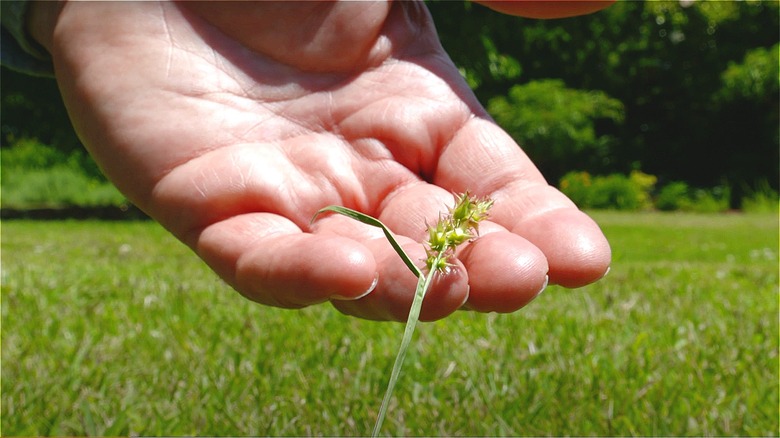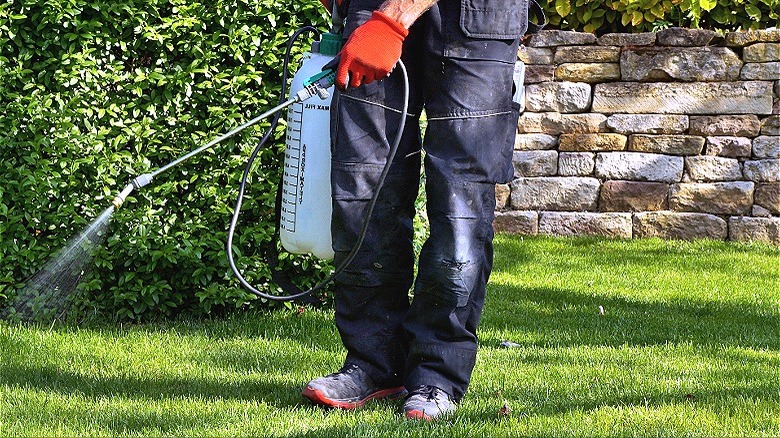Get Rid Of Pesky Sandburs Once & For All With These Expert Tips
Sandburs, also known as burr stickers or grassburs, are common throughout Arizona, Texas, New Mexico, and other states with hot, dry weather. Besides being a pesky weed, the spikes on the seed pods of sandburs will stick to your skin or clothes if touched, and they can be difficult or painful to remove. If you have pets or children, identifying sandburs and keeping these thorny weeds out of your yard is a must. Sandburs thrive in areas that lack nutrients and love sandy soil. The weed often grows in lawns with St. Augustine or Bermuda grass types and can be an annual or perennial.
According to Chrissie Segars, Ph.D., an AgriLife Extension turf specialist in Texas, keeping your grass healthy is a great way to begin eradicating grassburs. "Sandburs thrive in poor soils, so you want to improve all nutrients in general with fertilizer," Segars told AgriLife Today. "Promoting healthy, dense turfgrass is the best defense against most pest weeds, including sandburs."
How to improve your grass to eliminate sandburs
Proper fertilization and watering practices will improve the health of your grass, giving it the strength to help smother pesky sandburs in your yard. When putting more nutrients in your soil, Chrissie Segars suggests considering what type of grass you're working with to help determine what nutrients it needs. "Only add phosphorous and potassium according to the soil test and nitrogen according to recommendations for your turfgrass type, use of the area, and management capabilities, because St. Augustine grass and Bermuda grass have different needs," she said (via AgriLife Today).
Making sure not to under or overwater your grass is crucial for helping it thrive and choke out weeds. Soaking your lawn every once in a while rather than watering it a little every day can be beneficial in helping it grow while diminishing sandburs. When mowing, keeping the grass on the short side and using a bag to catch the clippings as you go will lessen the amount of grassbur seeds that spread.
"Catching reproductive structures of mature weeds lowers the population of seed you'll have to deal with in the future, and not catching the clippings and those seed pods can potentially help them spread to new areas of your lawn," Segars explained. "These practices should be performed consistently and properly to make your lawn a place where turfgrass thrives and makes it difficult for weeds like sandburs to emerge and multiply."
Using herbicides against sandburs
While maintaining the health of your grass is an effective first line of defense against sandburs, using herbicides can help to eliminate them completely. With pre-emergent herbicides, you'll be able to kill the weeds before they start popping up. For this method to work, it's important to apply the herbicide before sandbur seeds begin germinating, which can happen when soil temperatures fall in the range of 52 to 72 degrees Fahrenheit.
Pre-emergent herbicides may have to be applied to your lawn several times to eradicate these weeds. Chrissie Segars told AgriLife Today that pre-emergents with active ingredients such as oryzalin, indaziflam, pendimethalin, and dithiopyr are the best for treating sandburs. Once grassburs appear in your yard, it can be harder to get rid of them. Most post-emergent herbicides sold at retail stores are not formulated for sandburs, but Imazaquin, Katana®, and Celsius WG can be effective.

